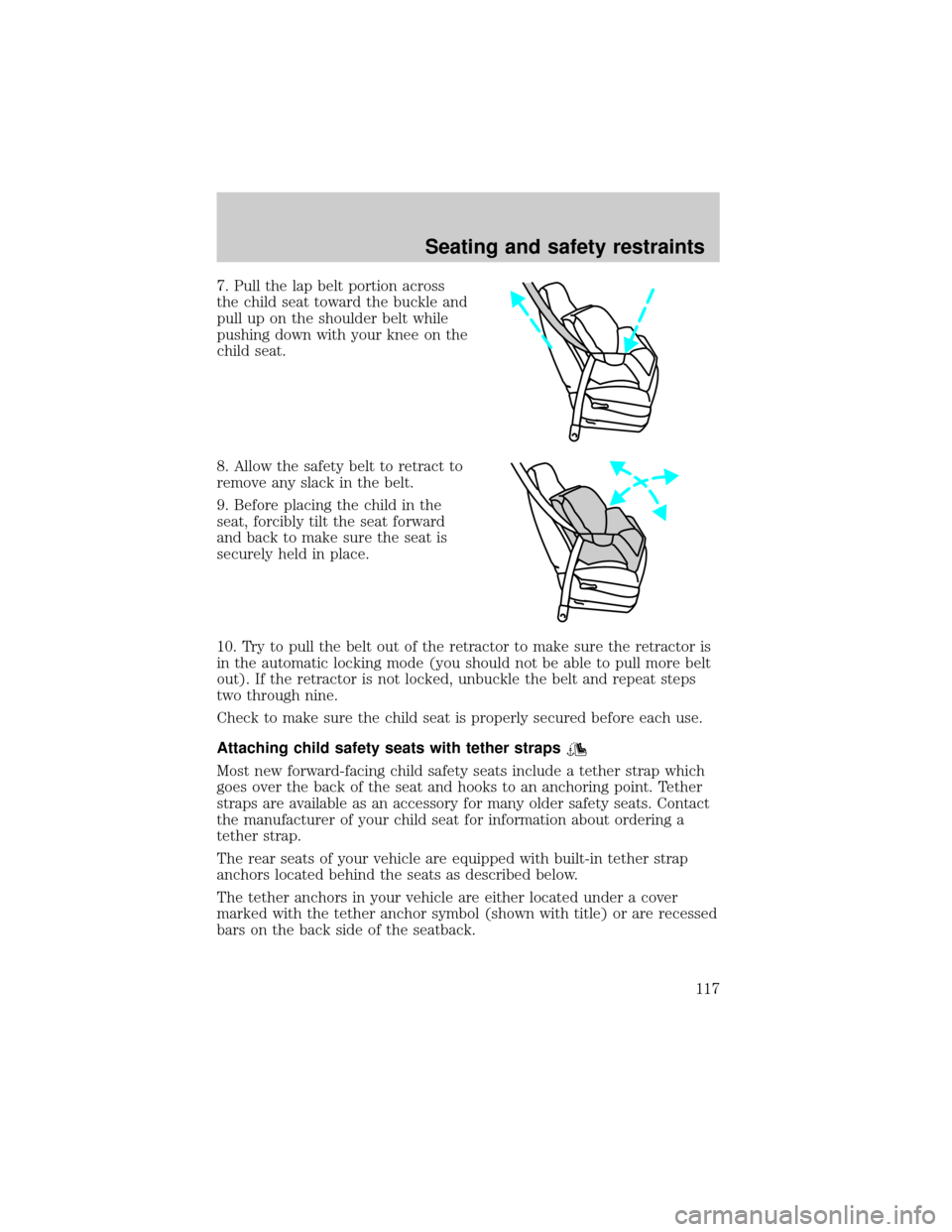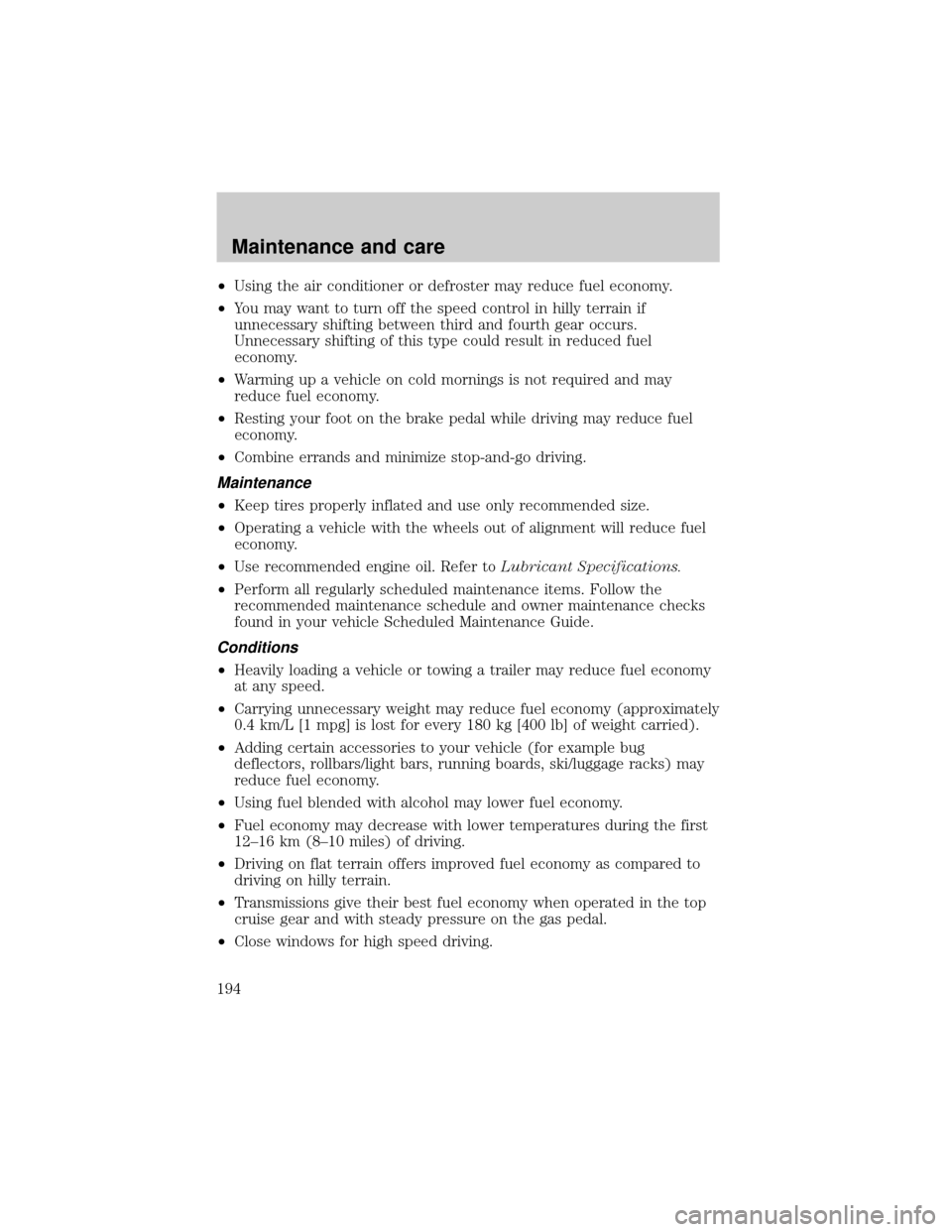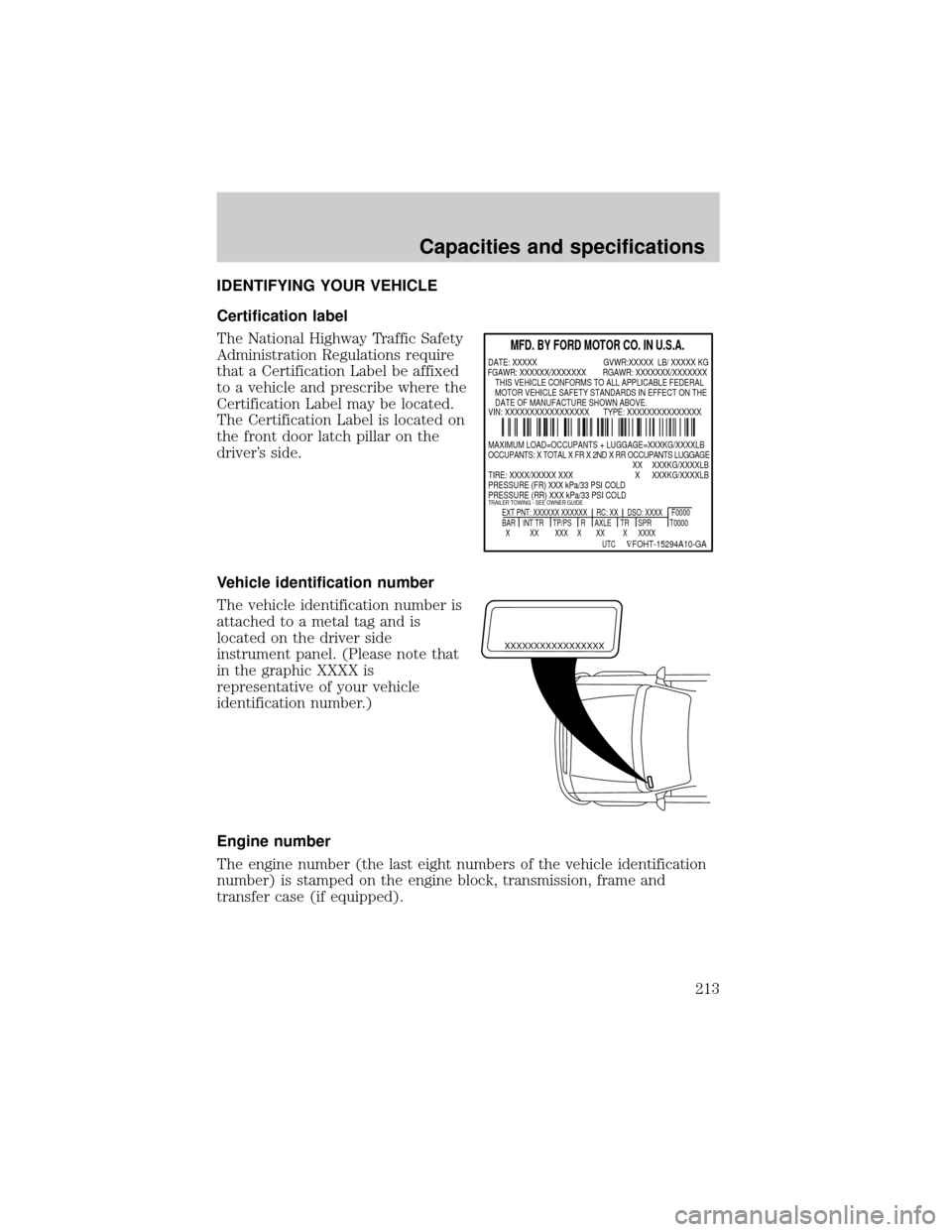2000 LINCOLN CONTINENTAL tow bar
[x] Cancel search: tow barPage 117 of 232

7. Pull the lap belt portion across
the child seat toward the buckle and
pull up on the shoulder belt while
pushing down with your knee on the
child seat.
8. Allow the safety belt to retract to
remove any slack in the belt.
9. Before placing the child in the
seat, forcibly tilt the seat forward
and back to make sure the seat is
securely held in place.
10. Try to pull the belt out of the retractor to make sure the retractor is
in the automatic locking mode (you should not be able to pull more belt
out). If the retractor is not locked, unbuckle the belt and repeat steps
two through nine.
Check to make sure the child seat is properly secured before each use.
Attaching child safety seats with tether straps
Most new forward-facing child safety seats include a tether strap which
goes over the back of the seat and hooks to an anchoring point. Tether
straps are available as an accessory for many older safety seats. Contact
the manufacturer of your child seat for information about ordering a
tether strap.
The rear seats of your vehicle are equipped with built-in tether strap
anchors located behind the seats as described below.
The tether anchors in your vehicle are either located under a cover
marked with the tether anchor symbol (shown with title) or are recessed
bars on the back side of the seatback.
Seating and safety restraints
117
Page 194 of 232

²Using the air conditioner or defroster may reduce fuel economy.
²You may want to turn off the speed control in hilly terrain if
unnecessary shifting between third and fourth gear occurs.
Unnecessary shifting of this type could result in reduced fuel
economy.
²Warming up a vehicle on cold mornings is not required and may
reduce fuel economy.
²Resting your foot on the brake pedal while driving may reduce fuel
economy.
²Combine errands and minimize stop-and-go driving.
Maintenance
²Keep tires properly inflated and use only recommended size.
²Operating a vehicle with the wheels out of alignment will reduce fuel
economy.
²Use recommended engine oil. Refer toLubricant Specifications.
²Perform all regularly scheduled maintenance items. Follow the
recommended maintenance schedule and owner maintenance checks
found in your vehicle Scheduled Maintenance Guide.
Conditions
²Heavily loading a vehicle or towing a trailer may reduce fuel economy
at any speed.
²Carrying unnecessary weight may reduce fuel economy (approximately
0.4 km/L [1 mpg] is lost for every 180 kg [400 lb] of weight carried).
²Adding certain accessories to your vehicle (for example bug
deflectors, rollbars/light bars, running boards, ski/luggage racks) may
reduce fuel economy.
²Using fuel blended with alcohol may lower fuel economy.
²Fuel economy may decrease with lower temperatures during the first
12±16 km (8±10 miles) of driving.
²Driving on flat terrain offers improved fuel economy as compared to
driving on hilly terrain.
²Transmissions give their best fuel economy when operated in the top
cruise gear and with steady pressure on the gas pedal.
²Close windows for high speed driving.
Maintenance and care
194
Page 213 of 232

IDENTIFYING YOUR VEHICLE
Certification label
The National Highway Traffic Safety
Administration Regulations require
that a Certification Label be affixed
to a vehicle and prescribe where the
Certification Label may be located.
The Certification Label is located on
the front door latch pillar on the
driver's side.
Vehicle identification number
The vehicle identification number is
attached to a metal tag and is
located on the driver side
instrument panel. (Please note that
in the graphic XXXX is
representative of your vehicle
identification number.)
Engine number
The engine number (the last eight numbers of the vehicle identification
number) is stamped on the engine block, transmission, frame and
transfer case (if equipped).
MFD. BY FORD MOTOR CO. IN U.S.A.
EXT PNT: XXXXXX XXXXXX RC: XX DSO: XXXX F0000
BAR INT TR TP/PS R AXLE TR SPR T0000
X XX XXX X XX X XXXX
UTC
ÑFOHT-15294A10-GA
MAXIMUM LOAD=OCCUPANTS + LUGGAGE=XXXKG/XXXXLB
OCCUPANTS: X TOTAL X FR X 2ND X RR OCCUPANTS LUGGAGE
XX XXXKG/XXXXLB
TIRE: XXXX/XXXXX XXX X XXXKG/XXXXLB
PRESSURE (FR) XXX kPa/33 PSI COLD
PRESSURE (RR) XXX kPa/33 PSI COLD
TRAILER TOWING - SEE OWNER GUIDE
DATE: XXXXX GVWR:XXXXX LB/ XXXXX KG
VIN: XXXXXXXXXXXXXXXXX TYPE: XXXXXXXXXXXXXXX FGAWR: XXXXXX/XXXXXXX RGAWR: XXXXXXX/XXXXXXX
THIS VEHICLE CONFORMS TO ALL APPLICABLE FEDERAL
MOTOR VEHICLE SAFETY STANDARDS IN EFFECT ON THE
DATE OF MANUFACTURE SHOWN ABOVE.
XXXXXXXXXXXXXXXXX
Capacities and specifications
213
Page 229 of 232

charging system ........................11
high beam .................................10
oil pressure ...............................11
safety belt ...................................9
service engine soon ....................8
traction control active ..............11
turn signal indicator .................10
Load limits .................................135
GAWR ......................................135
GVWR ......................................135
trailer towing ..........................135
Locks
autolock .....................................88
childproof ..................................77
doors ..........................................74
Lubricant specifications ....210,211
Lug nuts, anti-theft ...................155
Lumbar support, seats ...............94
Message center .................14,16,20
air leveling disabled .................14
air ride switch off .....................14
check air ride system ...............14
check air suspension ................14
menu button .............................19
reset button ..............................20
system check button ................16
warning messages .....................17
Mirrors .........................................65
automatic dimming
rearview mirror .........................73
cleaning ...................................205
heated ........................................77
programmable memory ............84
side view mirrors (power) .......76
Moon roof ....................................65
Motorcraft parts .................191,209
Octane rating ............................190
Odometer .....................................13
Oil (see Engine oil) ..................165
Overdrive ...................................131
Panic alarm feature,
remote entry system ..................82Parking brake ............................126
Parts (see Motorcraft parts) ....209
Power distribution box
(see Fuses) ...............................151
Power door locks ........................74
Power steering ...................128,129
fluid, checking and adding ....174
fluid, refill capacity ................209
fluid, specifications ..........210,211
Radio ............................................30
Relays .................................143,152
Remote entry system ............81,82
illuminated entry ......................84
locking/unlocking doors ...........81
opening the trunk .....................82
panic alarm ...............................82
replacement/additional
transmitters ...............................83
replacing the batteries .............82
Safety belts (see Safety
restraints) ................12,95,96,97,98
Safety defects, reporting ..........225
Safety restraints ...........95,96,97,98
belt minder .............................100
cleaning
the safety belts ................104,208
extension assembly ..................99
for adults .........................96,97,98
for children .............................112
lap belt ......................................99
warning light
and chime ........................9,11,100
Safety seats for children ..........113
Seat belts
(see Safety restraints) ...............95
Seats ............................................92
child safety seats ....................113
cleaning ............................207,208
easy access/easyout feature ....95
heated ........................................94
memory seat .............................84
Index
229